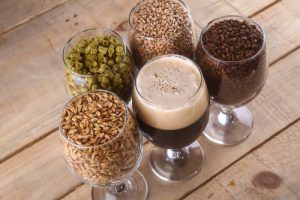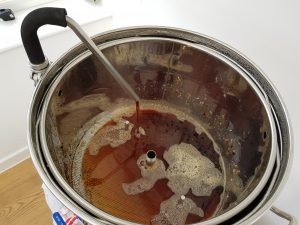Mashing
 The main ingredient for this first step is malted barley grains, which have been crushed (ie. rolled in a mill to crack open the grains) – this is known as the ‘grist’. Certain other malted grains may also be added to the mash, such as rolled oats and wheat grains. Unmalted grains (known as ‘adjuncts’), such as flaked oats and maize, may also be added to the mash.
The main ingredient for this first step is malted barley grains, which have been crushed (ie. rolled in a mill to crack open the grains) – this is known as the ‘grist’. Certain other malted grains may also be added to the mash, such as rolled oats and wheat grains. Unmalted grains (known as ‘adjuncts’), such as flaked oats and maize, may also be added to the mash.
The grains are mixed with hot water (the ‘liquor’) to form the mash. This is referred to as ‘doughing-in’, and should produce a thick porridge like consistency. The mash is then left, at a constant temperature, for an hour or so. The hot water dissolves the starches and activates the enzymes in the malt producing fermentable sugars. This is the ‘sweet wort’, that is, the unfermented beer before hops have been added.
The ratio of water to grain (the mash ‘thickness’) can vary but it’s generally accepted to use between 2.5 and 3 litres of water per kg of grist. The lower this value, the thicker the mash.
Mash temperature is very important, and will determine how fermentable the sugars will be. Higher temperatures create sugars that are more complex and therefore less likely to be fermented by the yeast. This will leave residual sweetness and body in the beer. Lower temperatures create simpler sugars which are more easily fermented. This will give a beer higher in alcohol with a drier finish. So, a ‘trade-off’ between the two. Read on ….
The mashing process allows the different enzymes in barley to go to work converting starch into sugars and breaking down proteins into less complex proteins and amino acids. For single-infusion mashing, the important enzymes for the home-brewer are Alpha Amylase and Beta Amylase. Alpha Amylase breaks down starch into non-fermentable sugars, at an optimum temperature of 70ºC. Beta Amylase breaks down starch into fermentable sugars, at an optimum temperature of 64ºC. So the mash temperature must be in between these two.
The majority of home brewers aim for 66°C (i.e. closer to the temperature for the extraction of fermentable sugars), but some recipes require a few degrees either side of this. To reach the required mash temperature, the water initially needs to be hotter as the cool grains will lower the temperature. This is known as the ‘strike’ temperature – I usually find that 3 or 4°C higher than the required mash temperature is about right. Other factors like ambient environment and temperature of equipment will also have an effect. Once mixed, the temperature can be adjusted simply by adding hot or cold water (or, like I do, use a temperature-controlled mash tun).
An alternative to a single-infusion mash is the stepped mash. This is usually only necessary (for the home-brewer) for recipes with large amounts of unmalted adjuncts, or continental lagers which use moderately modified malts. Step mashing is dealt with on a separate page.
The important thing with mashing though is to maintain the temperature constant (within 2°C either way) for the whole of the mash period (usually between 60 and 90 minutes). If you don’t achieve this, it may cause the beer to taste different.
The water used for mashing can be treated beforehand to adjust the alkalinity (ie. the water pH) – refer to Water Treatment for more on this. The purpose of this is to make sure the mash pH falls within the desired range of 5.2 – 5.6, which has a number of benefits, such as improved enzyme activity, more efficient conversion, better hop extraction in the boil, better protein precipitation, improved yeast health and clarity of the finished product to name but a few. In all cases pH needs to be less than 6 to avoid tannin extraction, both during the mash and while sparging.
 Even if the liquor has been tested for alkalinity beforehand, it is still worth testing the pH of the wort during the mash. This is done quite simply with a pH meter (see photo). On occasions, I’ve adjusted the alkalinity of the mash (and sparge) water before commencing, and still found that the pH value is outside the desired range during the mash. Fortunately, the pH can still be adjusted during the mash. In fact some brewers don’t bother with testing the pH beforehand, and just adjust it during the mash as necessary – this is usually where the local tap water is not too alkaline. pH may be reduced (ie. made more acidic) by the gradual addition of Carbonate Reducing Solution (CRS) (1 ml at a time up to a maximum of 5 ml for a 23 litre batch), or increased (made more alkaline) by the addition of sodium bicarbonate (no more than 2 teaspoons for a 23 litre batch).
Even if the liquor has been tested for alkalinity beforehand, it is still worth testing the pH of the wort during the mash. This is done quite simply with a pH meter (see photo). On occasions, I’ve adjusted the alkalinity of the mash (and sparge) water before commencing, and still found that the pH value is outside the desired range during the mash. Fortunately, the pH can still be adjusted during the mash. In fact some brewers don’t bother with testing the pH beforehand, and just adjust it during the mash as necessary – this is usually where the local tap water is not too alkaline. pH may be reduced (ie. made more acidic) by the gradual addition of Carbonate Reducing Solution (CRS) (1 ml at a time up to a maximum of 5 ml for a 23 litre batch), or increased (made more alkaline) by the addition of sodium bicarbonate (no more than 2 teaspoons for a 23 litre batch).
Decoction is an additional stage at the end of the mash and is occasionally recommended. Decoction mashing is a traditional and intensive method of mashing. While the method was once used by most breweries, today decoction is a controversial topic among brewers. Many German brewers (among others) claim that it develops malt character, depth, and superior foam. Others feel that it is a waste of energy and time, and is unnecessary now that modern well-modified malts are available to everyone. The basic principle of decoction is to remove a part of the mash, boil it, and return it to the main mash, which is held at a constant temperature.
The design of the equipment required for mashing consists of a container (the mash ‘tun’) in which there is a false bottom. The false bottom is a sieve (ie. perforated with lots of tiny holes), which is positioned an inch or two above the actual bottom of the mash tun. This is to allow the liquid (hot wort) that filters through the mash bed into the space below.
 Some mash tuns (like my Royal Catering Mash Tun) have an additional feature, which allows for the continuous recirculation of the wort during mashing. This consists of a pump which takes the wort from below the false bottom, and re-injects it onto the top of the mash bed. Recirculating the mash wort is the optimal way to save time, while also greatly improving the clarity and quality of your beer. It’s widely accepted that if you are an all-grain brewer and you are not recirculating your beer, you are not making the best beer you can make. However, an important point is that the recirculating system must be such that the mash temperature is maintained. This is what is known as a RIMS – a Recirculating Infusion Mash System.
Some mash tuns (like my Royal Catering Mash Tun) have an additional feature, which allows for the continuous recirculation of the wort during mashing. This consists of a pump which takes the wort from below the false bottom, and re-injects it onto the top of the mash bed. Recirculating the mash wort is the optimal way to save time, while also greatly improving the clarity and quality of your beer. It’s widely accepted that if you are an all-grain brewer and you are not recirculating your beer, you are not making the best beer you can make. However, an important point is that the recirculating system must be such that the mash temperature is maintained. This is what is known as a RIMS – a Recirculating Infusion Mash System.
The other advantage of continuous recirculation during the mash is that you don’t need to bother with the process of recirculating the ‘first runnings’ after the mash (and before sparging), because that has been done during the mash. If it is necessary, recirculation of the first runnings is known as ‘vorlauf’. To vorlauf in German means to run ahead. But in brewing terms, it’s referring to the first runnings that come out of the mash tun when the bottom drain is opened. Brewers define vorlauf as a recirculation process as these cloudy first runnings are ahead of what they want, so they will recirculate this wort back on top of the mash to be re-run through the grains and cleared of the cloudiness in the process.
